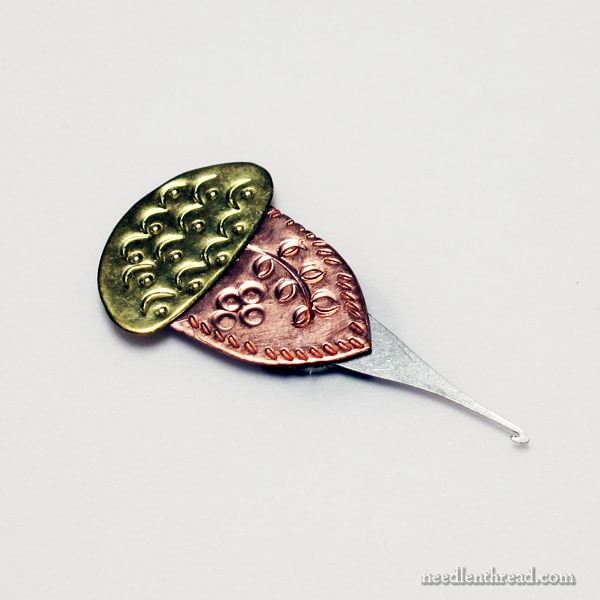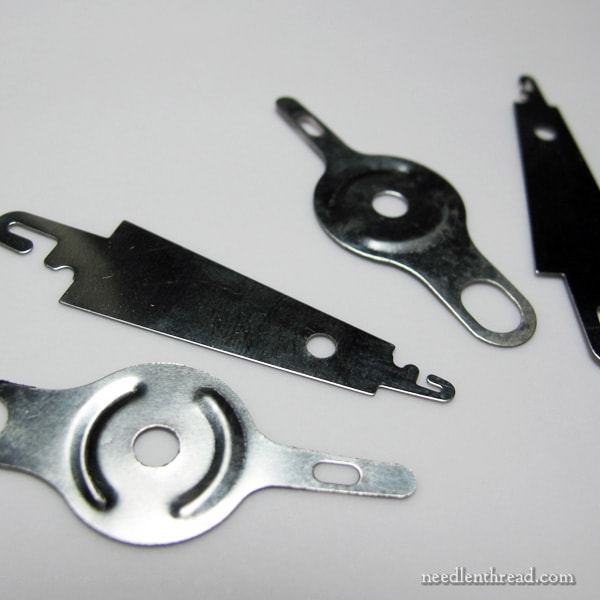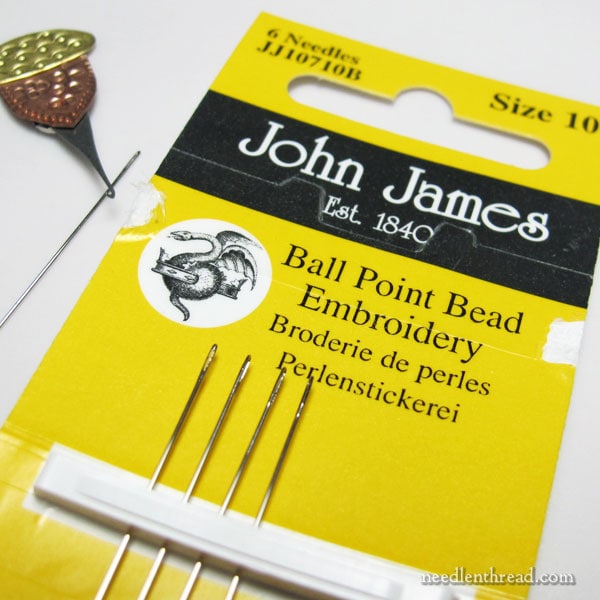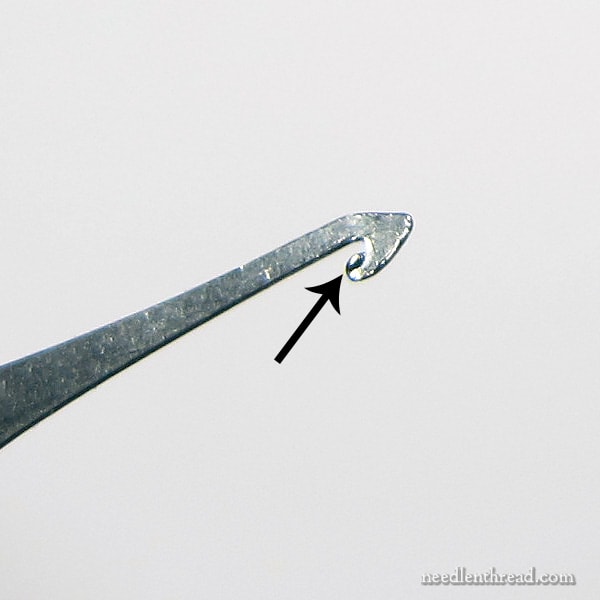I’ve been working lately on some tiny embroidery projects. Technically, they’re petit point – they’re worked on 48 count silk gauze. And they’re a lot of fun! (I will share them soon!)
As I work on any embroidery project, I troubleshoot to make sure the project can be accessible to anyone who wants to undertake it, too. And this can sometimes be tricky, especially when working with small scale embroidery.
When it comes to seeing small scale stitching, there’s always lighting and magnification to help.
But when it comes to doing certain things – for example, threading a little needle – it’s sometimes hard to find a solution if difficulties arise.
I’ve written about threading needles in this article here (read the comments, too). No matter what kind of needle I use, the pinch and saw method of threading always sees me through.
But for some folks, threading a needle is more difficult – and not being able to thread a fine needle can put them off their stitching game altogether. So I figured I’d seek out a fine needle threader that actually works for small needles.

When it comes to threading a needle, most of the ubiquitous wire needle threaders out there can’t handle small needles.
Those inexpensive wire threaders (you know the kind: a tiny wire attached to a piece of tin or plastic) might fit into the needle’s eye initially. But once you add the thread and start to pull the wire back through, the tight fit often causes the wire to break or to separate from the tin or plastic base.
The most stable type of needle threader has a flat, thin hook on it. The hook is an integral part of the body of the threader. It’s not simply a wire attached to a base.
So I started searching for a flat-hook needle threader with a teeny tiny hook that would fit into smaller needles’ eyes.
I doubted I’d find one.
Most of the flat hook needle threaders looks like these, or some configuration thereof:

These are excellent needle threaders. They’re inexpensive, but they last. They’re easy to see. They do the job. But they are large – even their small ends are large! The small ends work on about a #7 crewel needle fairly easily.
I’m using #10 beading needles, which are significantly smaller!

Lo and behold, eventually, I came across the acorn threader featured in the first photo above. It’s made by Puffin & Co.
They make two sizes of decorative flat-hook threaders, and one of them is a micro threader.
The threaders come in different configurations (a bunny instead of an acorn, for example), so you can get all seasonal with them if you want!
The threader has a fine magnet on the back of the micro threader, to keep it from slipping away somewhere (it’s pretty small, after all).
Now, the micro threader is not necessarily an easy fit into the #10 beading needles, especially with the silk thread I’m using (a single strand of Soie de Paris). But it does work, if you use a careful rocking motion to pull the threader and the thread through the eye.

In fact, I think the threader would work even better if it didn’t have a small burr on the end of the hook. I’m pretty sure this was the luck of the draw – it just happened that I got a threader with a burr on it.
If you’re at a shop, you can always feel the end of the hook carefully to check for a burr, but if you’re ordering online, you won’t have the opportunity to feel the threader first, obviously.
Even with the tiny burr (which I’m going to try to buff out), the micro threader still works in my little needle – and that’s an amazing thing!
I love it! And I’m glad I took a chance and tried it!
An Up Close Look at Needle Threaders & How They Work
I found a video on different type of needle threaders here, by Cathe at Needle in a Haystack. She covers different threaders and how to use them correctly. The Puffin micro threader is included in the video, as well as the other threaders shown above and the typical wire threaders.
If you have trouble threading your needles and you’ve wondered about needle threaders, the video is a great place to start exploring possibilities!
Where to Find Needle Threaders
If you have a local needlework shop or even a local quilting shop, you’ll probably find a decent selection of needle threaders available there.
Some threaders, you can find at chain fabric stores on the notions wall.
I ordered my Puffin & Company micro threader through Needle in a Haystack, here on their needle page. Just scroll all the way down towards the end of the page for the ordering information. Make sure to choose the micro threader if you’re looking for a really small threader!
You can also order from Puffin & Company directly here, or you can at least browse through the different designs for the threaders.
Since the price is the same in either place, I ordered from Haystack because I needed a few other little items. (No, really, I did! I “needed” them!) Saves on shipping, after all!
So, there you have it. A tiny flat hook needle threader that works in small needles. And it’s cute, to boot!
Do you have any needle threader recommendations, for those struggling to thread smaller needles? I’d love to hear your suggestions. Please join in the conversation below – you might just save another stitcher’s sanity with your ideas!
Ok, back to the grindstone! You have a marvelous Wednesday now, ok?







As usual, Mary suggests, Anya buys! Since I am also a knitter/spinner/weaver, the motif I chose is the precious little sheep. Thanks for the wonderful discovery of this marvelous tool.
Best,
Anya
I love stitching on silk gauze with beading needles. To thread up, I use the old fashioned wire threaders that are inserted into a bit of tin. When I buy a package, I lay them all out on the counter on a sheet of waxed paper, and put a drop of SuperGlue on the base where the wires are attached. Let them dry and you are set. I rarely pull out the wires when inserting them in a beading or other very small needle now.
Great idea!! If I had a nickle for every needle threader I’ve ripped apart. Thanks again.
I’ve been using the Puffin needle threaders for a while now and they really are great. My local wool shop Badger Brook Farm in Gilmantin, NH carries them in her shop. They work for any thread, the small for the smaller needles and the larger ones for 7’s and larger. I use it for floss and pearl cotton and really just about any thread and needle.
I use a wire needle threader called Ultrafine with my Japanese Embroidery needles. It is sturdier than most wire threaders and I haven’t had one break yet. It has a white rectangular tab. There is a packet of three needle threaders of different sizes called the Threader Collection which has it. You can also buy that size alone but they are harder to find. I got mine from Mary Alice Sinton at bluebonnetstudio.com I tried the Puffin but it was too big for those needles.
I have the same ultrafine threader that came in a Japanese bead embroidery kit for a Mary Alice Sinton class. It works well with the teeny tiny Japanese beading needles and seems reasonably sturdy. I haven’t broken it yet. 😉
I use a dab of gorilla glue on the cheap metal threaders to hold the wire tight and they last forever!
I’ve got several of these, but the best one I’ve found for #10 and #12 beading needles is the Colonial Ultra Fine threader; it’s a wire one, but finer than the usual ones. It’s a bit fragile but it fits easily through a #10 beading, and snugly but OK through a #12.
Would the large eye beading needles work for this Mary? They’re a needle of strong wire that is split in two in the center. They’re a dream to thread and work with for beading, but I don’t know if they would work for embroidery.
Hi, Alessandra – no, they are far too long. I’m using shorts. I’m stitching with no more than 6” of thread in the needle at a time, and often less.
I love the Puffin and Co. needle threaders. I have one in each size and have ordered more as little gifts for a couple of stitch-minded friends. If you live in Canada, I would suggest looking for a local supplier who stocks them, as shipping from the company was pricey.
Is the micro threader small enough to thread the smaller eyes of straw/milliners needles?
No, probably not. The beading needles have a slightly elongated eye. You might look around for the Japanese beading Needle threader that some of the other folks are talking about in the comments. It sounds like it would work.
Actually, I did use the micro threader with milliners needles when I was working on a Brazilian embroidery project. I had to wiggle it a a little but it got those rayon threads through and saved me a lot of aggravation!
I’ve used these threaders from puffin & co. for several years and absolutely love them. I found them on sale
at Stitching Bits and Bobs, haven’t checked lately if they are still on sale.
Definitely recommend them.
Teri
Wonderful and informative article Mary, (as the usually are) I always learn something new when I read your blogs. It’s enlightening to know what you don’t know that you don’t know.
One night I was having a terrible time threading a small needle with one strand of DMC. I knew it should work because it was the same needle and the same thread I’d used before. In desperation I threaded the needle with a loop of sewing thread and used that to pull the embroidery thread through. It was hard to pull it through the eye but once done I was ready to continue stitching with the single thread.
I do Brazilian Embroidery and most of use a wire threader called a Black Beauty. It works very well but to make sure that the wire doesn’t come loose I put a drop of nail polish on the back where the wire is anchored. Works well!
I love love love my Puffin threaders. (I have both sizes.) I have poor vision and was threatened with having to give up stitching because, between my tremor and my eyesight, I couldn’t thread a needle. Thanks to Puffin, I am still happily stitching away.
Mary, please update this on whether the filing worked. I heard wonderful things about these threaders but bought one that had a burr. Two years later I ordered another, but again there was that burr which snagged on everything. If filing works I may have to try again. Thank you
Ok, I’ll let you know!!
some p320 sandpaper would remove that burr and leave a nice polished finish.
Exactly!! 🙂
I’ve recently found your site because I want to get back into embroidery more, now that my children are all mostly grown up. I’ve been embroidering off and on since I was about 10, over 40 years. I prefer surface embroidery because it is more flexible and forgiving that anything that needs counting. Most of the things I have made over the years, I have given away. I’m wondering what you do with the hundreds of pieces of embroidery you must have accumulated over the years. As a somewhat minimalist, I worry about starting something that will just end up being unused.
Pretty much everything I do as a major project is given away. Small samples that I work up for the website end up in binders of samples I use when I need to demonstrate something – although lately I’ve been finishing some for hanging in my studio. And most everything else I stitch is usable as a finished item or decoration. I really only have one piece of my own embroidery on a wall in my house. I do have several kitchen towels, though, that are embroidered. I use them all the time for all things kitcheny, from dish drying to covering up bread baskets, etc. You can’t really go by me for the number of stitched goods, though. I do this for a living. And I have a dedicated studio for needlework with wall space there if I want it. Most people who stitch as a pastime probably aren’t going to produce as many small samples of things, I’m guessing.
If you are using even finer needles than a #10 beading needle the other option is either the Clover Double Fine Threader, which has 2 wire ends or the Colonial Needle Ultra Fine Threader. I’ve been able to use both of these on the Bohin Textile Conservation needles which are more like a #15 embroidery needle. So it’s a really fine eye. I just added them both to the online catalog (we got them recently because we started carrying the Bohin Textile Conservation needles).
Hello Mary
I use size 12 Tapestry needles and I thread them with a very fine, strong wire threader made by My Big Toe. Regards Jan
Thank you for the suggestion for a needle threader . I ordered it and a FEW other items! .
I have a great threader for heavier threads and I was surprised it wasn’t in the catalog. It is made by Clover and has a green cover. It will pull any weight thread and is invincible.
Thank you for your great articles. I am constantly recommending your site and FB page to people who need help with their stitches!
Mary, I have tried all those you pictured and the wire one that is lit from Clover. The wire ones are frustrating because because they break so easily. I have found a simple solution: take a length of silk, put it over your fore finger and work it into the eye of the needle as you would crewel wool, pull it into the eye but do not undo the loop, put the loop over the thread you want in the needle and draw the loop back out of the needle pulling the working thread into the eye. Lots of words to describe an action….this also works when you want to anchor short “tails”
Yes, you’ll find these methods described in the article I linked to on threading needles. Lots of tricks for threading in that article and the comments, if you have difficulties threading a needle.
Thank you, Mary. Old Arthur interferes with threading a needle these days. Can you tell me why LoRan threaders for larger needles are no longer magnetic? So annoying! Probably for my ‘ convenience.’ Best, Charlotte
It’s not that they’re not magnetic – I don’t think they ever had a magnet actually on them, but they would hold onto a magnet – it’s that they are thinner than they used to be, so they just don’t have enough to them to hold onto a magnet. If you have two together, they will, for some reason. If you have a magnetic needle minder, you can slide them under the magnet, rather than trying to get them to stick to the top of the needle minder.
Thank you so much for this post! I know I told you this, but for everyone else, I’m trying to break my habit of licking my thread, and bought a DMC brand 3-in-1 needle threader from my local craft store (the travel time to my nearest dedicated needlework store is prohibitive to someone who works full time), thinking that it would work with my DMC brand needles. The smallest threader barely went through the eye of a #9 embroidery needle, and when I tried to pull the thread through, the eye BROKE! So I am very glad for this post!
I use the good old fashioned needle threader from Mill Hill and haven’t broken one yet (other brands always break on the first usage). They also have a very fine needle threader that you can get from The Silver Needle. I’ve been pretty fortunate, though. When using a small eyed needle, I normally can get it threaded without assistance. In a pinch when those fluffy ends just don’t want to be threaded, I use scotch tape or masking tape to tame the thread into submission and cram it into the eye. 🙂
I’ve never used a needle threader – I don’t do ultrafine work – and I’ve never so much as seen one of the hook-style threaders before. You learn something new every day (especially reading this blog)! The tip about the two sides of the eye being different is something I’d never thought of before, but well worth remembering. Thank you!
My tip for needle threading is specific to people who, like me, don’t have depth vision (my eyes don’t work together – try threading a needle with one eye closed and you’ll see the effect). I always have my thread hand and my needle hand touching each other to create a mental map of where everything is.
Don’t you have those ones https://www.rascol.com/A-233692-enfile-aiguilles-rascol.aspx?tracking=Doofinder in the USA? Very fin ones!
Hello – the wire needle threaders last a bit longer if you put a touch of hot glue on the area where the wire connects to the puller. I can’t wait to try some of the needle threaders you suggest. Thank you – Kay
Hi Mary, did you ever finish that miniature tapestry tree of life on the 56 count gauze, or has that been back-burnered? I love all your embroidery, (and there is such a variety), but I found that one really fascinating! It is SO tiny.
Thanks,
Susan in Texas
I’m still working on it! But yes, it’s on the back burner for the moment. I’d like to work on it again soon, though! Right now, I’m designing and stitching a set of “miniatures” (not to-scale miniatures, but four mini designs on 48 ct silk gauze). Because they’re small pieces, they don’t take as long to stitch (relatively speaking). And they’re awfully satisfying! But in the scheme of stitching, when you’re working on something like 48 count silk gauze, that’s still a heck of a lot of stitches in a small space. It doesn’t work up quite as quickly as surface embroidery in the same sized space! 🙂
Dear Mary
These are really lovely needle threaders, they look pretty and seems like they do the job on small needles a great idea. It is a shame they are not available in the UK as they would be a great addition to my embroidery accessories. I’m still looking for the best needle threader around that doesn’t break after a couple of uses but unable to decide which one is best. Thanks for sharing your new needle threader which are really lovely and for the photos and links very useful.
Regards Anita Simmance
Thanks for the link to the micro needle threader! have just ordered one – but they are expensive! Still, maybe I’ll only ever need this one – have broken plenty of the wire/plastic ones.
fabulous find Mary. I’ve been looking for a tiny needle threader for ages. Thank you for sharing!
I have a needle threader that works on the John James Size 13 Beading needle…
I recently read your write-up of the Puffin micro needle threader and ordered a couple for myself for Christmas. I love it! I don’t use a needle threader very often but occasionally I just don’t seem able to get that needle onto my thread. I never had a lot of luck with those wire threaders, they always seem to break. So happy I read your Puffin recommendation. Thank you!
I wish you a very happy 2020.
Joan Kolar.
You could probably smooth down that burr with an inexpensive diamond-grit micro file set. I have a set from Harbor Freight, and there should be similar sets all over Amazon/eBay.
Fabulous! I’ve been looking for a micro threader for forever because, honestly, I didn’t know that’s what I was looking for. Thank you for this informative post. My eyes will also thank you when the one I ordered from your link gets here!
how is that going to get into a size 10 beading needle
Well, I’ll check it again, but the one I have – without the tiny burr – worked on my size 10 needles. Not sure if they were beading needles. But I’ll give it a try to see!
Hi there,
I just read your article on the Puffin and company needle threader.
I am looking for a needle threader to use with my embroidery.
I usually use 3 stranded cotton with size 5-7 embroidery needles.
I’m wondering if the needle threader will fit through this size from your experience?
Can they also take 6 strands if needed?
Kind regards Danielle
Hi, Danielle – the Puffin threader I reviewed is a micro threader, so it’s good for one strand in very fine needles, like 10 and above (although it would work in size 9, too). If you look at these needle threaders: https://shop.needlenthread.com/product/needle-threaders – any of the “classic” size will work for you, as long as you’re using the right size needle for 6 strands (which would be a 3 or larger). But for 5-7 needles and three strands, the classic is perfect.
This is such a neat and helpful gadget! I love how it can make threading needles so much easier, especially for those of us with less-than-perfect eyesight. Thanks for sharing!